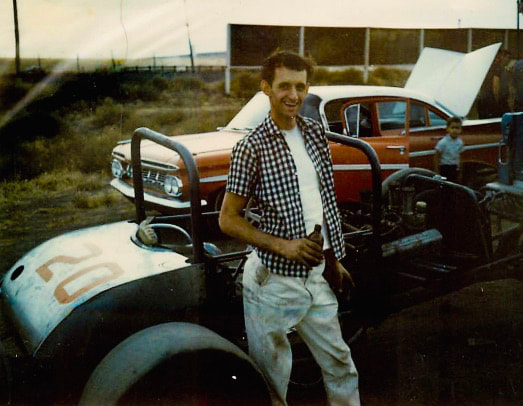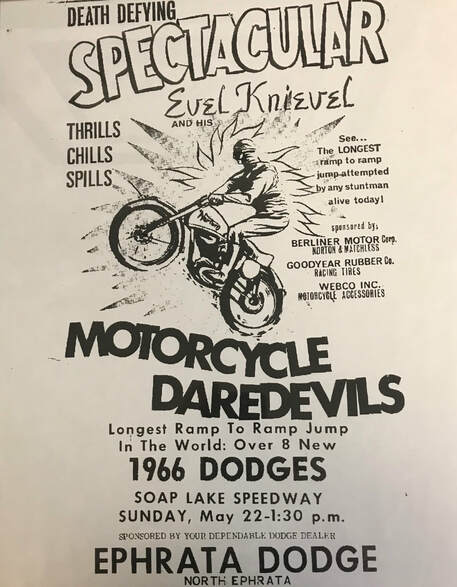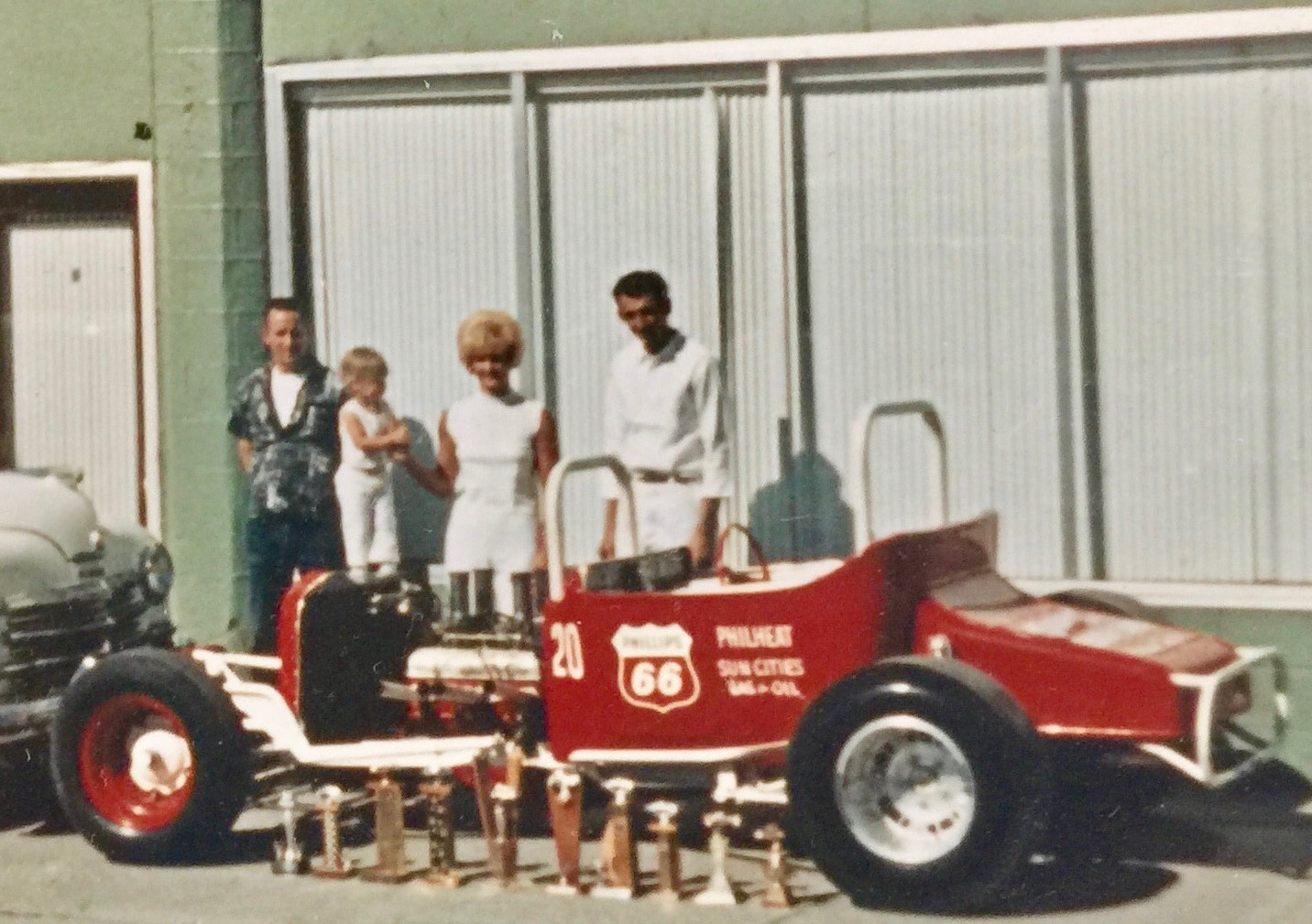
The need for speed. It was a contagion across the U.S. in the 1950’s and ’60’s, and Soap Lake, WA, had it bad. From the early 1950’s to the very early 1970’s—the Soap Lake Speedway revved the town on Saturday nights with the sounds and excitement of stock car racing.
Mike Arvan was a local kid who fell hard for car racing. One of seven brothers (and one sister), Mike remembers all the Arvan boys working in Soap Lake gas stations. Mobil, Flying A, Chevron, Union 76, Phillips 66, Exxon, the town had them all. Mike figures he himself worked in “darn near all of them”. But, it was at Larry’s Body Shop where his racing fever really hit. Larsen Air Base at Moses Lake was at full strength in those days, and Mike recalls that a lot of those guys were at Larry’s building stock cars. Mike spent much of his own spare time hanging out at Larry’s. The Soap Lake Speedway predated Mike Arvan’s racing involvement by several years. He remembers as a kid of five or six watching cars race on Soap Lake’s original dirt track located out where Shady Acres is now. About 1947, they moved the track to the site of the old Soap Lake Rodeo grounds. Mike recalls that, “all they had was a post and a cable between the grandstand and the cars.” But then, the whole operation went big time in 1953 when they laid an asphalt track. The effort was spearheaded by The Soap Lake Lion’s Club. The Columbia Basin Racing Association sponsored the races. The speedway was a quarter of a mile asphalt track with a steep bank—very steep. The track was egg shaped, not totally oval. One corner was a lot tighter than the others. It made for a tough racing challenge. There were bleachers and concession-stands—all new. The grandstand side of the track was banked, but the other parts of the track were pretty level. Mike reports, “you could go off the track pretty easy at the east end right where the school is right now. Pretty exciting at times.” The grandstands had a capacity of about 700 and they were regularly filled to capacity. Because of the large number of tourists summering at Soap Lake, nearly half the fans were usually from the west side of the state. The stock cars raced most weeks on Saturday nights. During early weeks of spring and fall, however, nighttime temperatures would be cool. So, races ran on Sunday afternoons. Normally, Mother’s Day opened the season and Labor Day weekend concluded it. On a typical Saturday night, three different classes of cars would compete: 1. “C” — Claimer class. A driver would run his (inexpensive) car in a C race. Anyone (not a racing association member) could then claim the car for $100—minus the tires and fire extinguisher 2. SS — Super stock class— models between 1951-1961. Engines had to be the same brand as the cars and the cars were required to be full bodied and entirely American made. Tires could be any size. 3. “A” - Modified class. These cars were handcrafted and the “A” Races were the ones fans really came to see. Engines had to be 280 cubic inches. These cars would sometimes reach 90MPH on the quarter mile Soap Lake track There were trophy dashes for each class. Then, there’d be a couple heat races; then “B” mains, and then “A” mains. Four laps for a trophy race; 8-12 laps for a heat race; 25-50 for a main event—though on special weekends like Suds and Sun and Labor Day, the main event would be 100 laps. Purses were generally modest, but on big weekends, they could reach $1000. On race nights, drivers would just show up. They came from Spokane, Yakima, Ellensburg, the Tri-Cities and all the towns in Grant County. Soap Lake drew some famous drivers. Tom Sneva (Indianapolis 500 winner in 1983) raced at the Speedway along with his brothers, Jerry, Jan, Blaine, Ed (“Babe”), and their dad, Ed. Bruce Garber ( Mead, WA) was a regular at Soap Lake; Bruce had a ride at Indy in 1985.
There were some hard tragedies at the Speedway. Don Osborn was a successful and popular driver from Ellensburg. Reports the Grant County Journal:
Don Osborn from Ellensburg, racing hard, tried to bring his “8-Ball” car into a better position. He died almost instantly when his wheel went over the wheel of another car. He safety belt broke at the center, releasing the shoulder harness, and he was violently thrown from the car. The car itself repeated flipped end over end until it came to rest on its top. Osborn’s wife watched the split-second tragedy from the stands. There was speculation that Osborn’s seat belt—while meeting track standards—may have been too old.
Osborn’s was the second fatality at the Soap Lake Racetrack. Five years prior, Jan Steward from Grand Coulee was killed. Jan’s father, John, was driving at Soap Lake on the day of the Osborn crash. The race was an annual memorial event for his son.

Infrequently, the Soap Lake Speedway would feature non-stock car entertainment. Evel Kneivel came to Soap Lake early in his career. The showman was in the midst of developing his death-defying act. In those days, Evel (born Robert Craig Kneivel) owned a Honda bike shop in Moses Lake. Mike Arvan describes him as a “down to earth guy— kind of a redneck. He’d leave that Honda shop every day in Moses Lake and wheelie all the way down Third Avenue. That’s the way he lived.”
Evel Kneivel performed at the Speedway Sunday, May 22, 1966. His act was promoted as, “the longest ramp to ramp (motorcycle) jump in the world, over eight brand-new 1966 Dodges”. The vehicles were provided by Ephrata Dodge. Mike Arvan describes the jump, “It was amazing when he came and set up for the show that night. The track was too short so he had to jump off the bank of the racetrack and come off onto the ramp. That night, he ran up to the top of the ramp, stopped and looked at the crowd—rolled all the way back— and made a couple of wheelies. Then, he rode up the bank, came off of it and down the ramp over all the cars.” While Knievel’s jumps later in his career involved many more vehicles and much more danger, the cocky showman was at his best that long-ago night in Soap Lake. Mike Arvan himself was no slacker in the thrills and spills department. Another (infrequent) fan favorite of the Speedway was The Wall of Fire. Mike describes his one and only performance: “I did one of them. You’d start a cardboard wall of fire. Then you’d ride on the hood and go through the firewall. I only did that once; that was enough for me! They’d advertised it, but no one came through to do it. So, I ended up doing it. It was just a shot at putting on a bigger spectator event to draw in an even bigger crowd.” Mike had a couple other major life experiences at the Speedway. The first was truly life changing: “My wife and I met through racing. I needed a trophy girl and she was walking down the street.” Recalls Margie about that time, “Mike didn’t win a race that day; I didn’t get to kiss him; I had to kiss his friend! Mike did his racing when we were young; mostly I remember being in the hospital having babies when he was racing. Every May we had one, it seems.” 
The other event was planned but turned out far differently than Mike and Margie and hoped: “I did have a really bad day racing. It was when I wrecked the car pictured in the photo. I had sold the car two races before the championship race with the agreement I could run it in the season championship. And then I totaled it. I remember I went airborne. There wasn’t much in the way of roll bars back then—just two. No arm restraints. Lots of broken ribs and other bumps and bruises. I didn’t get another ride after that; I quit racing. But, I pretty well had planned on quitting racing that night—it was the reason I sold my car.” Racing was a lot of work. Mike Arvan remembers working all day at the body shop (Dewey’s — promoted below in a famous Soap Lake photo of a two-headed 1947 Plymouth), and then a night shift at the Grant County PUD. In his spare hours, Mike would repair and ready his stock car for another night of weekly racing at the Speedway. 
The Soap Lake Speedway closed up shop because of an unusual reason: Mike Arvan explains, “The sewage treatment plant was right behind the race track; it got pretty smelly during the summer time. The city wasn’t about to change the location of the track, so the Columbia Basin Racing Association finally decided to build a track in Ephrata. When they built the Ephrata track, that was when the Soap Lake track closed.”
So ended Soap Lake’s love affair with fast cars and hot Saturday nights at the race track. To relive some of the magic evenings, check out the YouTube video assembled by Soap Lake historian and videographer, Kathleen Keifer.
0 Comments
|
Archives
December 2019
Categories |



 RSS Feed
RSS Feed
